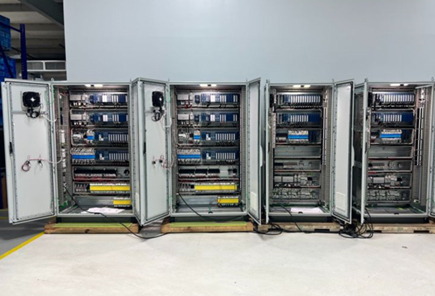In recent years, there have been significant advancements in the field of human-machine interface (HMI) technology. These panels, which allow users to interact with machines and systems, have become increasingly sophisticated and powerful. As a result, they are revolutionizing industries such as manufacturing, healthcare, transportation, and more.
One of the key advancements in HMI panels is the integration of touch screen technology. Gone are the days of physical buttons and knobs – now, users can simply touch the screen to control and interact with the machine. This has not only made the panels more intuitive and user-friendly but has also reduced the need for complex training and increased productivity.
Another major development in HMI panels is the use of gesture recognition. With this technology, users can control machines and systems with simple hand movements. For example, by waving their hand in a specific direction, they can change settings, adjust parameters, or even start and stop processes. Gesture recognition has opened up new possibilities for hands-free operation, making it ideal for environments where workers need to keep their hands free or where touch screens may not be practical.
Additionally, voice recognition has emerged as a game-changing feature in HMI panels. With advances in artificial intelligence and natural language processing, users can now speak commands to control machines and systems. This allows for an even more seamless and intuitive user experience, as individuals can simply speak their instructions rather than manually inputting them. Voice recognition has also improved accessibility for individuals with physical disabilities, making HMI panels more inclusive and accessible to a wider range of users.
One of the most exciting advancements in HMI panels is the integration of augmented reality (AR) and virtual reality (VR) technologies. These technologies overlay digital information onto the real world or immerse users in virtual environments, respectively. By integrating AR and VR into HMI panels, users can visualize and manipulate complex data, troubleshoot issues remotely, and even receive real-time guidance and instructions. This has tremendous potential in industries such as manufacturing, where workers can benefit from enhanced visualization, training, and remote collaboration.
As the technology continues to advance, HMI panels are becoming more intelligent and adaptive. They can learn from user interactions, recognize patterns, and anticipate user needs. This enables a more personalized and tailored experience, as the panels can adapt to individual preferences and optimize workflows.
In conclusion, the future of HMI panels is here, and it is incredibly exciting. The integration of touch screen technology, gesture recognition, voice recognition, augmented reality, virtual reality, haptic feedback, and artificial intelligence have transformed these panels into powerful tools for interaction and control. With the continued advancements in technology, HMI panels are set to revolutionize industries and enhance the way we interact with machines and systems.

